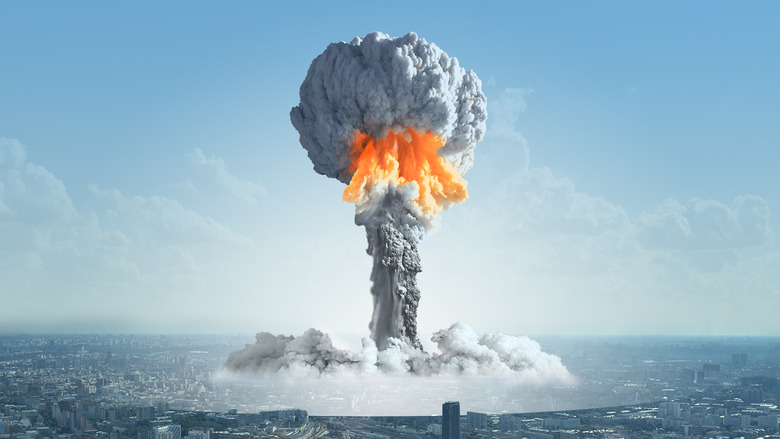What Is A Nuclear Chain Reaction?
A nuclear fission reaction takes place when the atoms of an unstable element are bombarded with neutrons, splitting the nucleus of each atom into smaller parts. If the split of each nucleus releases several high-speed neutrons that can then split more of the element's nuclei, a chain reaction takes place. As the extra neutrons split more nuclei, more energy is released and the chain reaction can result in an explosion such as that of a nuclear bomb. If the chain reaction is controlled by removing some of the extra neutrons, energy is still released in the form of heat, but an explosion can be avoided. The nuclear chain reaction is one of three types of nuclear reactions that have different characteristics and can be used in different ways.
TL;DR (Too Long; Didn't Read)
A nuclear chain reaction is a fission reaction that releases extra neutrons. The neutrons split additional atoms releasing even more neutrons. As the number of neutrons emitted and the number of atoms split rises exponentially, a nuclear explosion can result.
The Three Types of Nuclear Reactions
The Three Types of Nuclear Reactions
The nucleus of an atom stores a lot of energy that can serve useful purposes. The three types of nuclear reactions that use nuclear energy are radiation, fission and fusion. Medical and industrial X-ray machines use radiation from radioactive elements to create images of the body or in testing materials. Power plants and nuclear weapons use nuclear fission to produce energy. Nuclear fusion powers the sun, but scientists have not been able to create a long-term nuclear fusion reaction on Earth although efforts are continuing. Of these three types of nuclear reactions, only fission can create a chain reaction.
How a Nuclear Chain Reaction Starts
How a Nuclear Chain Reaction Starts
The key to a nuclear chain reaction is to ensure that the reaction generates extra neutrons and that the neutrons split more atoms. Because the element uranium-235 produces several neutrons for every split atom, this isotope of uranium is used in nuclear power reactors and in nuclear weapons.
The shape and mass of the uranium influence whether a chain reaction can take place. If the mass of uranium is too small, too many of the neutrons are emitted outside the uranium and are lost to the reaction. If the uranium is the wrong shape, for example a flat sheet, too many neutrons are lost as well. The ideal shape is a solid mass large enough to start the chain reaction. In this case, the extra neutrons hit other atoms, and the multiplication effect leads to the chain reaction.
Controlling or Stopping a Nuclear Chain Reaction
Controlling or Stopping a Nuclear Chain Reaction
The only way to control or stop a nuclear chain reaction is to stop the neutrons from splitting more atoms. Control rods made of a neutron-absorbing element such as boron reduce the number of free neutrons and take them out of the reaction. This method is used to control the amount of energy produced by a reactor and to ensure that the nuclear reaction remains under control.
In a nuclear power plant, the control rods are raised and lowered into the uranium fuel. When fully lowered, all the rods are surrounded by fuel and absorb most of the neutrons. In that case, the chain reaction stops. As the rods are raised, less of each rod absorbs neutrons, and the chain reaction speeds up. In this way the operators of the nuclear power plant can control and stop the nuclear chain reaction.
Problems With Nuclear Chain Reactions
Problems With Nuclear Chain Reactions
Although nuclear chain reactions in power plants around the world deliver substantial amounts of electric power, nuclear power plants have two main problems. First, there is always a risk that the control system based on control rods won't work because of technical failures, human error or sabotage. In that case there could be an explosion or a release of radiation. Secondly, used fuel is highly radioactive and has to be stored safely over thousands of years. This problem is still not solved, and used fuel remains at various nuclear power plants in most cases. As a result, practical uses for nuclear chain reactions have decreased in many countries, including in the United States.
Cite This Article
MLA
Markgraf, Bert. "What Is A Nuclear Chain Reaction?" sciencing.com, https://www.sciencing.com/what-is-a-nuclear-chain-reaction-13710238/. 19 March 2018.
APA
Markgraf, Bert. (2018, March 19). What Is A Nuclear Chain Reaction?. sciencing.com. Retrieved from https://www.sciencing.com/what-is-a-nuclear-chain-reaction-13710238/
Chicago
Markgraf, Bert. What Is A Nuclear Chain Reaction? last modified March 24, 2022. https://www.sciencing.com/what-is-a-nuclear-chain-reaction-13710238/
